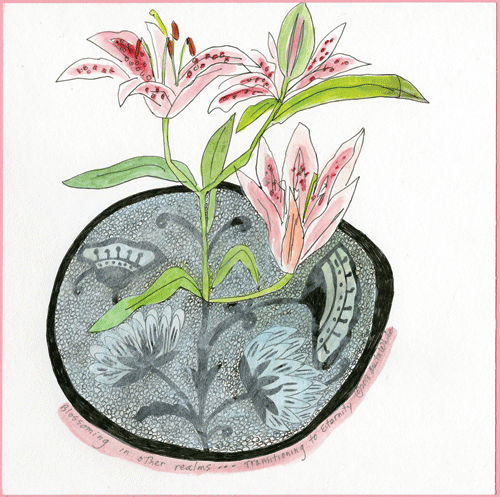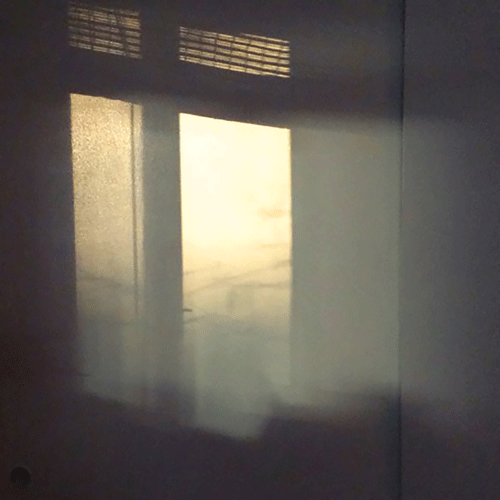By DORIS RUBENSTEIN
Has anyone close to you ever died? How did you react? Relief? Pain? Gratitude? Do you remember the deceased by saying Kaddish? Do you keep things that remind you of that person close to you, like pictures or a piece of jewelry?
Those experiences provide the theme for ” Life, Loss and Legacy,” the current show at the St. Paul Jewish Community Center’s Herman J. Birnberg Fine Art Gallery. The show, running through March 31, is a presentation of the now-interfaith Jewish Women Artists’ Circle.
According to the group’s coordinator, Lucy Rose Fischer, the decision to expand the group’s membership beyond the Jewish community grew from a project in 2016 when “…we invited a number of Christian artists to join us for an exhibit on community, which opened at the Benedictine Monastery … This was supposed to be a one-year interfaith project but we really liked the artists and they liked us, so we decided to continue working together.”
She explained further that “the topic of mortality is particularly interesting for an interfaith group. The experience is universal, but the rituals, customs and theology are often different across religions… This theme is intensely personal… During the time that we studied it and worked on our art, virtually all of us experienced significant losses of people we loved.”
Part of the artistic process for the JWAC is study. In this case, the teachers included Raleigh Kent, an Orthodox Jew who imparted Torah and halacha regarding the Hevra Kaddisha (burial society) and its role in burial customs. Also a teacher: Barry Baines, a physician, medical director of UCare and the author of Ethical Wills: Putting Your Values on Paper, who talked about legacy.
Several artistic themes seem dominant in “Life, Loss and Legacy.” Three pieces are triptychs, yet each is unique: Sandra Brick’s “The Tracks We Leave” takes its name from a Lakota proverb embroidered on a panel of sky-blue cloth, “We will be known by the tracks we leave.” This hangs beside a panel of fragmented mirrors.
Looking into the panel, the self becomes disintegrated, just as the body disintegrates after death and memories become disconnected and forgotten. The third panel is corkboard and visitors are encouraged to leave notes – like at the Kotel!

The second triptych is Anita White’s “Transition to Eternity.” Three mixed media drawings, arranged vertically, depict lilies and other flowers in various stages of blossom. It’s White’s tribute to the time she shared with her lifelong friend, Heidi, as she lay dying. She writes, “I attended to her spirit through these drawings wherein I perceived her soul blossoming into another realm.”
Jeanne Aaron’s batik on silk, “Fallen Leaves,” completes the triptych trilogy.
Legacy and memory are intertwined. That’s all that we Jews know, since our tradition tells us next to nothing about Olam ha-Ba. Myth gives us the personage of Malach ha-Mavet, the Angel of Death, who makes an appearance in Paula Leiter Pergament’s painting “The Gentle Hand of Death Cometh.”
Malach ha-Mavet is not a frightening ghost in this mixed-media portrait; rather, the angel wraps a comforting arm around the shoulder of the older woman, who could be anyone’s bubbie, who offers an amused smile. She’s not afraid of this ghost! She’s been waiting patiently for any visitor for quite some time.
It’s the image or idea of ghosts that is the second theme in the exhibition. Lucy Rose Fischer’s mixed media piece — employing her unique glass techniques — is titled “Sweet Ghosts.” But it is Joyce Lyon’s “Soki’s Room” that takes the viewer from the mundane into the spirit world. The digital photo print on unbleached Thai mulberry paper is protected with reflective glass.

Lyon writes, “In early morning on my last visit before she died, I photographed the luminous sky framed by the window of her room. The light seemed to dissolve substance … Beyond this, I have no words. The image must be enough.”
The photo itself has a ghostly quality to it, but it is not frightening, either, as in Pergament’s painting. However, whether by the intent of the artist or not, the viewer cannot help but see oneself reflected in the glass over the photo and becomes a somewhat ghostly image enveloped in the diffuse light of the window depicted.
The Birnberg Gallery director, Robin Awend, can choose from a plethora of artistic subjects for exhibit. What was the appeal of this particular show?
“Art is such a powerful tool for sharing stories, especially ones that are hard to tell. This exhibit is filled with beautifully moving work in a wide array of media that both heals and connects us to one another through the shared language of art,” she says.
The Birnberg Gallery manages to include even more artworks from “Life, Loss and Legacy” in its limited space than can be described in this equally limited space. Take a few minutes the next time you’ve exercised your body in the JCC’s gym to exercise your spirit at this show.
***
“Life, Loss and Legacy” will be on display through March 31 at the St. Paul JCC, 1375 St. Paul Ave., St. Paul. For information, visit stpauljcc.org.
(American Jewish World, 3.19)




















